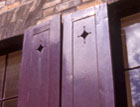How to perfect a Georgian exterior
William Palin wonders whether the renovation of his Georgian townhouse will be copied by others looking for perfect examples of restoration in the late 20th century


Like clothes, pleasing domestic architectural details have long been admired and copied by the fashion conscious. In early 18th century London, speculative builders of smart new residential areas such as Spitalfields and Soho always kept an eye on the competition, and good ideas were widely disseminated. As an occupier of a new house, the design of your doorcase, fanlight, brickwork and ironwork was important, and would have conferred status in the same way as the quality of the interior fixtures, fittings and furnishings.
* Find more on restoring Georgian property on our dedicated webpage
With the revival of these historic urban areas in the late 20th century, the replication of details became desirable once more. Often the only way of accurately restoring lost features was to look at those few examples that had survived the ravages of time, and to copy them. Because of this, certain houses became touchstones for those eager to plunder characteristic details.
In Spitalfields, for example, many of the houses have star-shaped holes cut in the exterior shutters (above). This detail (probably Victorian in origin), now ubiquitous, was originally found on just one house. That same building has an unusual and beautiful Regency doorcase with gesso detailing which, I notice, has recently spawned a double just two doors away.
In the modern age, where many of the subtleties of the traditional building crafts are less widely understood, this process of copying the best examples of joinery work, ironwork, and decorative finishes creates a healthy process of evolution. In an area such as Spitalfields, home to some of the country's most obsessive house restorers, only good ideas are taken up, and with them the best craftsmen.
The result is that, in some cases, the design uniformity of groups of Georgian houses, originally developed under a single hand but disrupted over time, has been restored. One of the best examples of this is in Wilkes Street where, over the past decade or so, a row of uniform three bay houses with round headed windows has been beautifully restored by the individual owners. These houses sport handsome Doric doorcases one of the trademarks of the carpenter, Marmaduke Smith, who developed the street in the 1720s.
Conversely, and in accordance with the laws of evolution, bad ideas tend to die out. And, on this subject, I am a little sensitive. No one has copied any details from the outside of my house. Perhaps it is the absurdly complicated shutter system I devised which features little chains to hold the bars in place (clever, but fiddly and vulnerable), or the deep sills which provide a perfect place for people on the Jack the Ripper tours to leave half drunk cups of tea.
Exquisite houses, the beauty of Nature, and how to get the most from your life, straight to your inbox.
Perhaps it is the odd positioning of the reproduced Victorian brackets holding up the cornice or the not quite right mouldings on the front door. Whatever the reason, it remains disappointingly original. The Georgian Group produces an excellent series of guides which get to grip with the details of 18th and early 19th century house design and restoration. Subjects addressed include doors, windows, brickwork and metal and ironwork. Visit www.georgiangroup.org.uk or telephone 020–7529 8920.
* Find more on restoring Georgian property on our dedicated webpage
Country Life is unlike any other magazine: the only glossy weekly on the newsstand and the only magazine that has been guest-edited by His Majesty The King not once, but twice. It is a celebration of modern rural life and all its diverse joys and pleasures — that was first published in Queen Victoria's Diamond Jubilee year. Our eclectic mixture of witty and informative content — from the most up-to-date property news and commentary and a coveted glimpse inside some of the UK's best houses and gardens, to gardening, the arts and interior design, written by experts in their field — still cannot be found in print or online, anywhere else.
